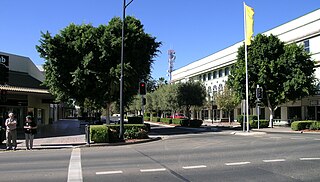
Moree is a town in Moree Plains Shire in northern New South Wales, Australia. It is located on the banks of the Mehi River, in the centre of the rich black-soil plains. Newell and Gwydir highways intersect at the town. It can also be reached from Sydney by daily train and air services.

Newell Highway is a national highway in New South Wales (NSW), Australia. It provides the major road link between southeastern Queensland and Victoria via central NSW and as such carries large amounts of freight. At 1,058 kilometres (657 mi) in length, the Newell is the longest highway in NSW, and passes through fifteen local government areas.

Boggabilla is a small town in the far north of inland New South Wales, Australia in Moree Plains Shire. At the 2021 census, the town had a population of 529, of which 43.5% identified as Aboriginal or Torres Strait Islander descent.
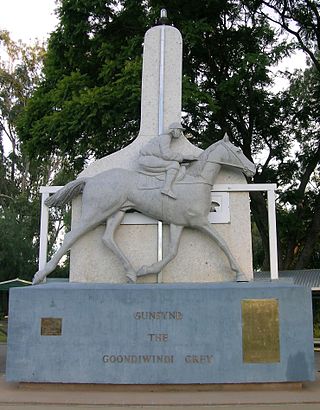
Goondiwindi is a rural town and locality in the Goondiwindi Region, Queensland, Australia. It is on the border of Queensland and New South Wales. In the 2021 census, the locality of Goondiwindi had a population of 6,230 people.

Mungindi is a town and locality on the border of New South Wales (NSW) and Queensland, Australia. The town is within Moree Plains Shire in New South Wales. Within Queensland, the locality is split between the Shire of Balonne and the Goondiwindi Region with the town in the Shire of Balonne. It possesses a New South Wales postcode. Mungindi sits on the Carnarvon Highway and straddles the Barwon River which is the border between New South Wales and Queensland. In the 2021 census, the locality of Mungindi had a population of 487 people in New South Wales and 124 people in Queensland, a total of 611 people.

Moree Plains Shire is a local government area in the North West Slopes region of New South Wales, Australia. The northern boundary of the Shire is located adjacent to the border between New South Wales and Queensland. The Shire is located adjacent to the Newell and Gwydir Highways and the North West railway line.
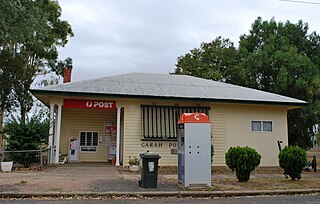
Garah is a town in north western New South Wales, Australia. The town is in the Moree Plains Shire local government area. At the 2016 census, Garah and the surrounding area had a population of 306.
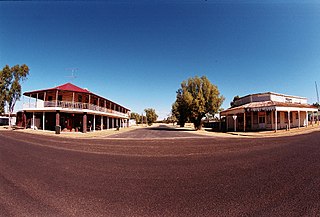
Boomi is a town in north western New South Wales, Australia. The town is in the Moree Plains Shire local government area, 728 kilometres (452 mi) north west of the state capital, Sydney, on the border on the New South Wales side of the MacIntyre River. Boomi is west of the Queensland town of Goondiwindi and north of Moree in New South Wales. At the 2016 census, Boomi and the surrounding farming area had a population of approximately 200.

The Shire of Balonne is a local government area in South West Queensland, Australia, over 500 kilometres (310 mi) from the state capital, Brisbane. It covers an area of 31,104 square kilometres (12,009.3 sq mi), and has existed as a local government entity since 1879. It is headquartered in its main town, St George.
The Bigambul people are an Aboriginal Australian people of the Northern Tablelands and Border Rivers regions of New South Wales and Queensland.

Cummeragunja Reserve or Cummeragunja Station, alternatively spelt Coomeroogunja, Coomeragunja, Cumeroogunga and Cummerguja, was a settlement on the New South Wales side of the Murray River, on the Victorian border near Barmah. It was also referred to as Cumeroogunga Mission, although it was not run by missionaries. The people were mostly Yorta Yorta.
The Tomkins incident on 30 November 2004 was an attack by two white farmers on two Aboriginal boys found trespassing on their property near Goondiwindi, a town on the border of Queensland and New South Wales in Australia.
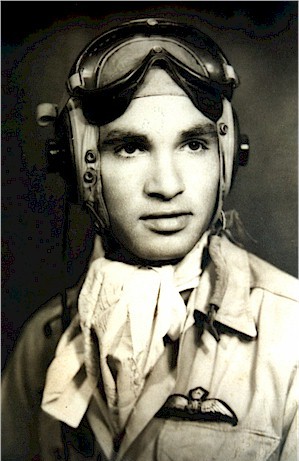
Leonard Victor "Len" Waters was the first Aboriginal Australian military aviator, and the only one to serve as a fighter pilot in the Royal Australian Air Force (RAAF) during World War II. Aboriginal people at the time suffered significant discrimination and disadvantages in Australian society, such as restrictions on movement, residence, employment, and access to services and citizenship. Born in northern New South Wales and raised in Queensland, Waters was working as a shearer when he joined the RAAF in 1942. Training initially as a mechanic, he volunteered for flying duties and graduated as a sergeant pilot in 1944. He flew P-40 Kittyhawks in the South West Pacific theatre, where he completed ninety-five missions, mainly close air support. By the end of the war he had risen to the rank of warrant officer. Following his discharge from the RAAF in 1946, he attempted to start a regional airline but was unable to secure financial backing and government approval. He went back to shearing, and died in 1993 aged sixty-nine.
Boolooroo Shire was a local government area in the North West Slopes region of New South Wales, Australia.
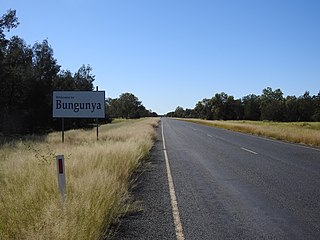
Bungunya is a rural town and locality in the Goondiwindi Region, Queensland, Australia. The locality is on the border of Queensland and New South Wales. In the 2021 census, the locality of Bungunya had a population of 62 people.
Canning Creek is a rural locality split between the Goondiwindi Region and the Toowoomba Region in Queensland, Australia. In the 2021 census, Canning Creek had a population of 21 people.

Maloga Aboriginal Mission Station also known as Maloga Mission or Mologa Mission was established about 15 miles (24 km) from the township of Moama, on the banks of the Murray River in New South Wales, Australia. It was on the edge of an extensive forest reserve. Maloga Mission was a private venture established by Daniel Matthews, a Christian missionary and school teacher, and his brother William. The mission station operated intermittently in 1874, becoming permanent in 1876. The Mission closed in 1888, after dissatisfied residents moved about 5 miles (8 km) upriver to Cummeragunja Reserve, with all of the buildings being re-built there.
Dawn was an Australian magazine created by the New South Wales Aborigines Welfare Board and aimed at Aboriginal Australians. It ran monthly from January 1952 until December 1968. Two issues were published in 1969, before the disbanding of the Aboriginal Welfare Board led to the publication ceasing.

The Wobbly Boot Hotel is an Australian pub located in the town of Boggabilla near the state border of New South Wales and Queensland. The current concrete building was constructed in 1935 to replace a 12-room wooden hotel on the same site that was destroyed by fire in 1934, leaving the railhead town without visitor accommodation. The new hotel was designed with modern amenities to help take advantage of the business opportunities brought by the recently opened Boggabilla railway line. Originally known as the Boggabilla Hotel, the name was changed to the Wobbly Boot, an Australian slang term used to describe the sensation of being drunk and unable to walk straight, during the tenure of publican Glen Bryan in the early 1980s.















